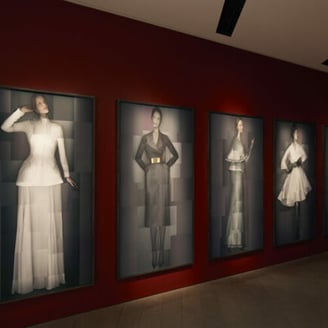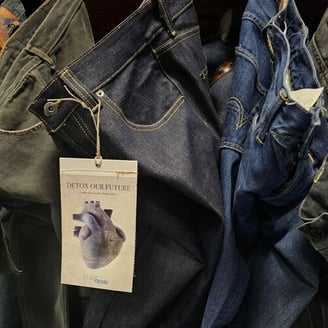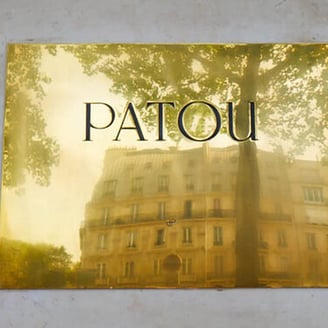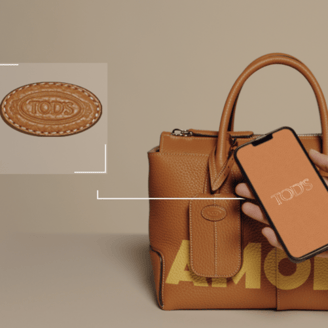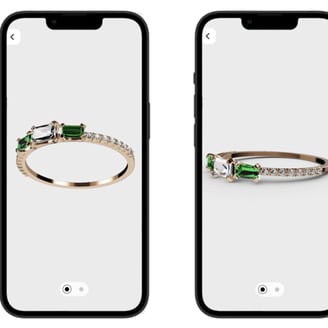Hyères Festival: Designers focus on sustainability, textile innovation, craftsmanship ability
The Hyères Festival, which ended on Sunday October 15, crowned as winners Belgian designer Igor Dieryck and Swedish designer Petra Fagerstrom. Between them, they snapped up the five prizes in the fashion category, with conceptual collections that were easy to characterise and sell. Many of the other finalists were much more committed to sustainability, and would have also fully deserved an award. For example, Alec Bizby, Jung Eun Lee and Fengyuan Dai, who showed genuine technical expertise with their in-depth materials research and great craftsmanship ability.

Bizby, aged 35, was born in Brecon, Wales, and is a volcanic character, both for his rapid-fire speaking and the incredibly inventive way in which he designs. His joyful, poetic collection, a tribute to his late father, who was a farmer and coal miner, teemed with original ideas. Like the cable-knit sweater made from jersey flakes looking like wool vermicelli, another sweater knitted from whipstitched scraps, a top made of old Victorian clay pipes collected from the river Thames’s mudflats, and a pair of trousers fashioned out of an airbag, which he then painted with abstract brushstrokes.
Not to mention the tweed-effect jackets made from a traditional Welsh woven blanket inherited from his family, which also inspired a patchwork coat assembled from fabric offcuts, and textured gilets that were part rug, part tapestry.

Last but not least, an amazing mohair set (a sweater and a pair of shorts) decorated with long wool threads and inspired by the look of patched-up workwear and by sashiko, a Japanese hand-embroidery technique for repairing worn clothes. To create this look, which he entered for the L’Atelier des Matières prize, Bizby completely deconstructed the fabric and wove the threads in the shape of long tassels. Once coupled together, the threads were knitted again using a machine, to highlight the neckline.
“I love playing with and making clothes. I’m working all the time,” said Bizby, who is also a painter, and graduated last year from the Central Saint Martins academy, having gone back to studying after working for years in a London pastry shop. “In parallel, in 2015, I launched a small sustainable label. But, during Covid, I thought, it’s now or never, and I fully committed to fashion,” Bizby told FashionNetwork.com. He is an upcycling specialist who uses artisanal techniques to develop his own materials, and this year he joined the Alexander McQueen studio.

Through the collection called Equilibre (balance), Fengyuan Dai subtly managed to tell the story of his personal journey, from his childhood and youth in China’s Hunan region, to his discovery of France. He settled in France 13 years ago, at the age of 24, initially to study plastic arts at the University of Aix-Marseille, and then to complete his education at the Atelier Chardon Savard school in Nantes.
Dai used stripes, checks, ribbons and straps like a frame, giving structure to garments that sometimes enveloped the body tightly, signifying “the highly hierarchical, codified social relationships and deeply held beliefs imbuing daily life” in his native country. He contrasted this approach with a sophisticated palette of soft, pastel shades, creating destructured silhouettes with an emphasis on layering, like jackets in which only the underlying structure remained, or coats transformed into skirts, and telling his own life’s story as an assemblage of different feelings and cultures.
Dai, 37, born in China and now a French national, impressed for his fabric work. He creates his own materials using recycled fabrics, offcuts, silk organza scraps, linen and cotton yarns from “his own excess output,” and garments from his previous collections, which he disassembles to make new ones. “We need to find solutions for creating garments from existing materials, it's this whole implementation process that interests me,” said Dai, who worked for Sandrine Philippe and Jean Paul Gaultier, where he eventually couldn’t be hired because of a visa issue. A year ago, he stopped working for others to set up his own label.

The career and work of cheerful South Korean designer Jung Eun Lee, 34, who likes to be called JL, are equally fascinating. She literally had to escape from her country and her family, who wanted her to become a model wife to a lawyer or doctor. With savings she scraped together by working on all sorts of menial jobs, Lee, who attended a textile school in Seoul, ran away to Germany, where she found an inexpensive community fashion school. In November 2013, she moved to Berlin, where she attended the Kunsthochschule Berlin-Weissensee art university.
In Hyères, Lee presented an extremely interesting collection, replicating feathers, fur and other animal skins through her meticulous, impressive work on textiles. She notably managed to simulate feathers perfectly using frayed fabrics, and did the same for the scales of a reptile’s skin. The very fine pleats in a white shirt, bended and painted over, resembled plumage-like striations. Lee experiments and innovates, tapping unsold inventory and scraps of fabric used for patternmaking to create ornaments for her garments. She also reinterpreted ancient techniques, such as inlay, embroidery, smocking and quilling.

Lee’s collection was 100% sustainable, and had a dark, baroque feel. She used innovative materials like cactus leather, gelled fabric sourced from fruit waste, silk derived from orange peel, and sequins made from recycled plastic. Since her internship at Chanel’s Métiers d’art, she has been dreaming of moving to Paris, to stay in touch with the expertise of French fashion houses. “I like experimenting with materials, but also being able to harmonise cuts, shapes and textiles,” she said.
Copyright © 2023 FashionNetwork.com All rights reserved.




